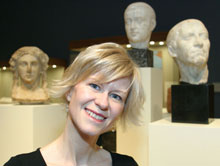Archaeologist digs the past

Jane Francis
In her own words, Jane Francis is the odd one out in the Department of Classics, Linguistics and Modern Languages. The reason? She is the only associate professor of classics who teaches archaeology.
The department employs three classics professors, two of whom teach Latin, Greek and ancient history, but Dr. Francis does not specialize in languages; her field of study is the material object.
While this isolates her somewhat, she is pleased by the response of students. In fact, requests for new courses are growing almost too fast.
“I could do things like field trips to Greece if we could expand, but these things are impossible to do if you are just one person.” She would like to see another archaeologist join the team.
This month, Francis was the chief organizer of a two-day colloquium on a collection of antiquities belonging to the Diniacopoulos family. The collection – 74 pieces of Greek and Roman painted pottery, glass, sculpture, terracotta and metal objects, and figurines – date from 1,500 BC through the third century AD.
The event drew experts and interest from all over the Eastern and Southern U.S. and Canada. About 20 speakers, Francis included, shared their knowledge and exchanged views.
The lectures on all aspects of the artifacts and the collectors, including sociological, historical, archaeological and art conservation perspectives. The event was timed to coincide with the opening of two new Mediterranean art galleries at the Montreal Museum of Fine Arts, where many of the Diniacopoulos pieces can be seen by the public.
“I had never done anything on this scale before,” Francis said. The project took over a year and a half to bring to fruition. “One of my jobs was to co-ordinate the finances, transportation and all the visiting speakers.”
Promoting the event was important. “It was the publicity that took up most of my time,” she said. “Once I started, I couldn’t stop!” She was also part of the production of a series of essays on the objects in the collection, The Diniacopoulos Collection in Quebec: Greek and Roman Antiquities, and one of the articles in this monograph.
The Diniacopoulos artifacts are on long-term loan from the Musée national des beaux-arts du Québec, and the acquisition delights Francis.
“Having the collection in Montreal will allow me to send students to see the true pieces rather than showing them pictures via a PowerPoint presentation or in a book. As a teaching resource, this is phenomenal.” It also represents a new connection between Concordia and the museum, which is just around the corner from the downtown campus, on Sherbrooke St.
Francis has always been a fan of Greek mythology, but it wasn’t until she was studying music at university and happened upon an elective course in classics that she got hooked. She moved into archaeology, and 16 years later, she holds three master’s degrees and a PhD. She specializes in Greek and Roman sculpture and pottery.
Next year, she plans to spend a sabbatical year on the island of Crete, analyzing archaeological sites and Roman pottery, as she has done every summer since the early ’90s. She is also collaborating with her husband, George W. M. Harrison, on a book about the archaeology of Rome and Crete.
“There’s lots of work to be done,” she said. “I’ll certainly continue doing it for the rest of my life.” As Olga Diniacopoulos once said, “Nothing is more precious for our lives and for the future of humanity than making direct contact with our history.”
For more information, go to ctr.Concordia.ca, follow the Archives link, and look for the two articles on the Diniacopoulos collection in the January 15 issue.